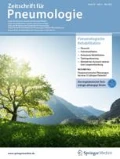Zusammenfassung
Die genaue Phänotypisierung von Asthma ist heutzutage essenziell für die effektive Behandlung von Asthmapatienten, die unter einer Monotherapie mit inhalativen Kortikosteroiden (ICS) nicht zu kontrollieren sind. Hier spielen neben klinischen Merkmalen immunologische Parameter eine zunehmende Rolle. Zu diesen immunologischen Biomarkern gehören eosinophile Granulozyten, das Gesamt-IgE und das spezifische IgE im Serum sowie die Fraktion des exhalierten Stickstoffmonoxids (FeNO). Möglicherweise werden demnächst auch weitere Marker, wie der Typ-2-Marker Periostin, in der klinischen Routine zum Einsatz kommen. Bei der klinischen Bewertung von Biomarkern sind allerdings immer noch viele Fragen ungeklärt. Nicht zuletzt durch den zunehmenden Einsatz der Biologika werden wir neue Einblicke in die verschiedenen Formen von Asthma und in die Rolle von Biomarkern beim Management von Asthma erhalten.
Abstract
A precise phenotyping of asthma has become an essential factor in the treatment of patients with asthma who are not well-controlled despite treatment with inhaled corticosteroids (ICS). In this regard, there is an increasing role for immunologic biomarkers such as eosinophils, total and specific IgE in serum and exhaled nitric oxide (FeNO). In the future, additional markers such as the type 2 marker periostin may become available in clinical practice. Of note, there are several unanswered questions regarding the clinical relevance of biomarkers in severe asthma. However, as a consequence of the increasing use of biologicals in clinical practice, we will gain new insights into the different phenotypes of asthma and the role of biomarkers in asthma management.


Literatur
Lommatzsch M, Stoll P (2016) Novel strategies for the treatment of asthma. Allergo J Int 25:11–17
Rackemann FM (1918) A clinical study of one hundred and fifty cases of bronchial asthma. Arch Intern Med 12:517–552
Gershon AS, Wang C, Guan J, To T (2010) Burden of comorbidity in individuals with asthma. Thorax 65:612–618
Lambrecht BN, Hammad H (2015) The immunology of asthma. Nat Immunol 16:45–56
Lommatzsch M (2016) Treatment of refractory asthma with antibodies. Dtsch Med Wochenschr 141:790–793
Lommatzsch M, Korn S, Buhl R, Virchow JC (2014) Against all odds: anti-IgE for intrinsic asthma? Thorax 69:94–96
Arbes SJ Jr. (2012) Do all asthmatics with atopy have atopic asthma? J Allergy Clin Immunol 130:1202–1204
Price DB, Rigazio A, Campbell JD et al (2015) Blood eosinophil count and prospective annual asthma disease burden: a UK cohort study. Lancet Respir Med 3:849–858
Burrows B, Martinez FD, Halonen M, Barbee RA, Cline MG (1989) Association of asthma with serum IgE levels and skin-test reactivity to allergens. N Engl J Med 320:271–277
Teach SJ, Gill MA, Togias A et al (2015) Preseasonal treatment with either omalizumab or an inhaled corticosteroid boost to prevent fall asthma exacerbations. J Allergy Clin Immunol 136:1476–1485
Kolkhir P, Church MK, Weller K, Metz M, Schmetzer O, Maurer M (2016) Autoimmune chronic spontaneous urticaria: what we know and what we don’t know. J Allergy Clin Immunol. doi:10.1016/j.jaci.2016.08.050
Gauvreau GM, Arm JP, Boulet LP et al (2016) Efficacy and safety of multiple doses of QGE031 (ligelizumab) versus omalizumab and placebo in inhibiting allergen-induced early asthmatic responses. J Allergy Clin Immunol 138:1051–1059
Manga V, Humbert M, Djukanovic R et al (2016) Blood eosinophils and serum IgE predict response to omalizumab in patients with severe allergic asthma: innovate trial post-hoc analysis. J Allergy Clin Immunol 137:AB16
Voskamp AL, Gillman A, Symons K et al (2015) Clinical efficacy and immunologic effects of omalizumab in allergic bronchopulmonary aspergillosis. J Allergy Clin Immunol Pract 3:192–199
Barnes PJ, Dweik RA, Gelb AF et al (2010) Exhaled nitric oxide in pulmonary diseases: a comprehensive review. Chest 138:682–692
Karrasch S, Linde K, Rucker G et al (2017) Accuracy of FENO for diagnosing asthma: a systematic review. Thorax 72:109–116
Petsky HL, Kew KM, Chang AB (2016) Exhaled nitric oxide levels to guide treatment for children with asthma. Cochrane Database Syst Rev:. doi:10.1002/14651858.cd011439.pub2
Bos LD, Sterk PJ, Fowler SJ (2016) Breathomics in the setting of asthma and chronic obstructive pulmonary disease. J Allergy Clin Immunol 138:970–976
Izuhara K, Conway SJ, Moore BB et al (2016) Roles of periostin in respiratory disorders. Am J Respir Crit Care Med 193:949–956
Hanania NA, Korenblat P, Chapman KR et al (2016) Efficacy and safety of lebrikizumab in patients with uncontrolled asthma (LAVOLTA I and LAVOLTA II): replicate, phase 3, randomised, double-blind, placebo-controlled trials. Lancet Respir Med 4:781–796
Wenzel S, Castro M, Corren J et al (2016) Dupilumab efficacy and safety in adults with uncontrolled persistent asthma despite use of medium-to-high-dose inhaled corticosteroids plus a long-acting beta2 agonist: a randomised double-blind placebo-controlled pivotal phase 2b dose-ranging trial. Lancet 388:31–44
Author information
Authors and Affiliations
Corresponding author
Ethics declarations
Interessenkonflikt
M. Lommatzsch erhielt Honorare für Beratungen und Vorträge von den Firmen ALK Abelló, Allergopharma, Astra Zeneca, Bencard, Berlin-Chemie, Boehringer-Ingelheim, Boston Scientic, Chiesi, GSK, Janssen-Cilag, MSD, Mundipharma, Novartis, Nycomed/Takeda, Sanofi, TEVA, UCB.
Dieser Beitrag beinhaltet keine vom Autor durchgeführten Studien an Menschen oder Tieren.
Additional information
Redaktion
M. Lommatzsch, Rostock
Rights and permissions
About this article
Cite this article
Lommatzsch, M. Phänotypen und Biomarker von Asthma. Pneumologe 14, 281–286 (2017). https://doi.org/10.1007/s10405-017-0108-z
Published:
Issue Date:
DOI: https://doi.org/10.1007/s10405-017-0108-z

